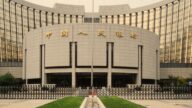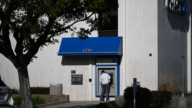【新唐人2014年05月19日訊】根據中共銀行業監督管理委員會15號發佈的最新資料顯示,截至今年一季度末,商業銀行不良貸款餘額達到6461億元人民幣,創下了近三年來的最高水準。不良貸款率的上升,反映了中國經濟增長放緩,經濟下行的現狀。那麼,中國經濟發展趨勢到底會怎樣呢?請看以下報導。
中國銀監會網站15號發佈的資料說,中國銀行業第一季度末不良貸款率增加541億元,達到了1.04%。這也是連續十個季度的上升。
根據大陸的監管規定,不良貸款,就代表著借款人無法足額償還借款。
浙江財經大學經濟與國際貿易學院院長謝作詩:「中國經濟一直泡沫化、高槓桿化。那麼,經濟現在去槓桿化、去泡沫化的過程中,房價在下行、經濟在下行,那當然壞賬會產生。我認為隨著房價經濟進一步下行,這個潛在的壞賬還會增加。」
大陸《財經網》指出,由於整個融資體系的風險,絕大部分都壓在銀行業身上,一旦資金鏈斷裂,必然會發生系統風險。《財經網》認為,種種信號顯示,銀行風控的警報已經拉響。
實際上,根據中共公開的資料顯示,2010年銀行業的淨利潤為7637億元,年增長率為14.26%﹔2011年是10412億,年增長率高達36.34%﹔而到了2012年,銀行的淨利潤達到了12386億,2013年也是超過1萬1千多億元。
按理來講,1%左右的不良貸款率完全可以被覆蓋。但銀監會在4月29號召開的2014年第一季度經濟金融形勢分析會上,非常強調嚴格對不良貸款餘額和比率「雙控」管理。
台灣證券分析人士Jack徐認為,從去年6月以來,銀行間的拆借利率大幅度飆升,出現錢荒,說明銀行貸款到期收不回來。真實反應了銀行的困境。
台灣證券分析人士Jack徐:「看一個國家或者一個地區的真正的不良放款或呆帳它的真實情況,坦白來講,去觀察它的隔天拆款利率,在當下,應該算是一個比較客觀的標準。」
Jack徐指出,不良貸款把大陸的經濟打回了原形。他說,以前的表面經濟增長,是建立在大規模的貸款上,不是真實的繁榮。
而大陸金融分析師任中道指出,從去年開始銀行收緊信貸的信號中,也可以看出銀行真是遇到麻煩了。
大陸金融分析任中道:「中共的這些數據都是不準確的,都是有水份的。相關的機構還有學者都已經曾經統計過,也就是說它的不良貸款率,其實沒有它說的那麼低。」
《法國興業銀行》去年底估算,如果考慮到產能過剩、中小城市房地產泡沫等潛在因素的負面影響,中國銀行業不良貸款率可能已經接近10%,也就是6萬多億,遠高於官方公布的1%的水準。
其實,《杭州銀行》去年的年報顯示,不良貸款餘額為20億5900萬元,年增加5億7700萬元,不良貸款率為1.19%﹔但《杭州銀行》在去年底還有沒有償還的到期貸款,高達41億8000萬元,同比暴增153%。
「浙江財經大學經濟與國際貿易學院」院長謝作詩指出,中國銀行是國有的,有他的特殊性,也就是可以讓全國人民一起來還債。
謝作詩:「我估計大規模的擠兌行為、銀行倒閉行為可能性不大。不大的原因並不是說泡沫化銀行的潛在壞賬不嚴重,而是說政府它可以用超發貨幣,像剝離不良資產等等一些辦法去救。」
不過,任中道指出,中共高層早就發現金融系統出問題了,他們也早釋放出解決的辦法來,那就是即將推出的銀行破產條例。
今年一月,銀監會副主席表示,銀監會正醞釀加快推出銀行破產條例。而業內人士也指出,今年內,銀行破產條例很可能推出。
一旦銀行破產,大陸儲戶們的錢將血本無歸。
採訪/易如 編輯/宋風 後製/李智遠
———-
Non-Performing Loans Continued to Increase: Banks On Alert
On May 15, the Chinese Communist Party (CCP) Banking Regulatory Commission launched it’s latest data. By the end of the first quarter of this year, the balance of non-performing loans (NPL) for commercial banks reached 646.1 billion yuan. This marked a record for the highest level in nearly three years. The rise of non-performing loan ratios is reflective of the current situation with the slowdown of China’s economic growth, and of an economic downturn. How will the the Chinese economy continue to trend? Please see the following report.
On May 15, the China Banking Regulatory Commission (CBRC) website released it’s latest information. By the end of the first quarter of China’s banking sector, the NPL ratio increased by 54.1 billion yuan, reaching 1.04%. This now reflects a rise over ten consecutive quarters.
In accordance with mainland China’s regulatory requirements, non-performing loans mean the borrower cannot repay loans.
Xie Zuoshi, Dean of the Faculty of Economics and International Trade, Zhejiang University of Finance: “China’s economy is a bubble, and is highly leveraged. The economy is now going through a de-leveraging process, with a downturn in house prices and the economy. This will of course produce bad debts. I think that with house prices taking a further downturn, the potential for bad debts will increase.”
Mainland China’s ‘Financial Network’ points out that, because of the vast majority of the risk in the entire financing system leaning on the banking industry, once a funding strand breaks, it is bound to create systemic risk. The Financial Network believes that a variety of signals shows that the bank’s risk control has pulled the alarm.
In fact, according to information published by the CCP, banking net profits in 2010 were 763.7 billion yuan. This marked an annual growth rate of 14.26%. In 2011, it was 1.0412 trillion, with an annual growth rate of 36.34%. In 2012, banking net profits reached 1.2386 trillion, and in 2013 it similiarily exceeded 1.1 trillion yuan.
Logically, about 1% NPL ratio can be overwritten. But on April 29, in it’s 2014 first quarter economic and financial situation analysis meeting, the CBRC very strictly emphasized the ‘duel control’ management on balance and ratio of NPL.
Jack Xu, a Taiwan Securities analyst, believes that since last June, the dismantling rate had a significant surge between banks. Money shortages occurred, indicating the maturity of bank loans are not being paid, reflecting the true plight of banks.
Jack Xu, Taiwan Securities Analyst: “To look at the actual bad loans and debts in a country or region, frankly speaking, is to observe its next call rate. At the moment, this should be considered as more objective criteria.”
Jack Xu points out that the NPL shows the real situation of China’s economy. He said that previously, the superficial economic growth was built on massive loans, not real prosperity.
Mainland financial analyst Ren Zhongdao suggests that from the beginning of last year, banks have tightened credit, which also reveals the banks are really in trouble.
Ren Zhongdao, Mainland Chinese financial analysis: “The CCP’s data is inaccurate, and it is all inflated. Related institutions and scholars have calculated that NPL ratio, in fact, is not as low as suggested.
The French bank Societe Generale gave last year’s estimates. Taking into consideration negative impacts, such as excess capacity, and medium and small cities’ real estate bubbles, Chinese banks NPL ratio may have been close to 10%. This is over 6 trillion, and is much higher than the official announced 1% level.
The Annual Report from Hangzhou Bank last year showed that NPL amounted to 2.059 billion yuan. This marked an annual increase of 577million yuan, and the NPL ratio was 1.19%. However, Hangzhou Bank hasn’t paid loans of up to 4.18 billion, which have increased 153%.
Xie Zuoshi points out that Chinese banks are state-owned. It has it’s particularity, that is, allowing people across the country to repay the account together.
Xie Zuoshi: “I believe that large-scale bank run behavior and bank failures are unlikely to happen. The reason is not to say that the bank’s potential bad debt is not serious, but that the government can rescue such as super-currency and peel off NPL assets.”
Ren Zhongdao points out that, the CCP leadership has long realized the problem in the financial system. They also released an early solution, which is the upcoming bank bankruptcy ordinance.
In January this year, the CBRC Vice Chairman said that CBRC is trying to accelerate the
introduction of bank bankruptcy ordinance. The industry also pointed out that this year, the bank bankruptcy ordinance is likely to be launched.
Once they allow banks to go bankrupt, the mainland depositors’ money will be lost without anything left.

























